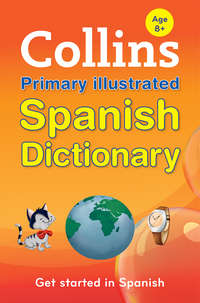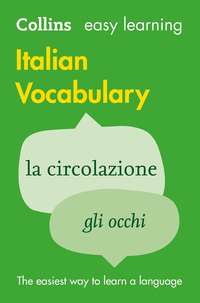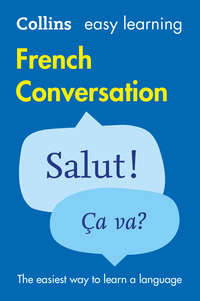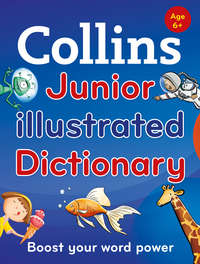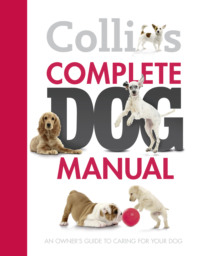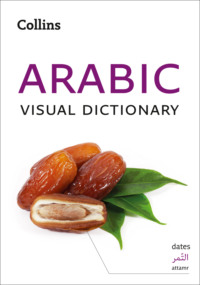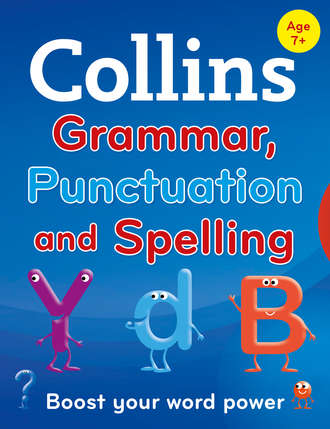
Полная версия
Collins Primary Grammar, Punctuation and Spelling
A noun phrase contains at least one noun.
a tall girl
an extremely tall girl
an extremely tall girl with piercing blue eyes
Adjective phrases
An adjective phrase contains at least one adjective.
a brown bear
a big brown bear
a big scary brown bear
Verb phrases
A verb phrase contains an auxiliary verb and sometimes an adverb.
I am enjoying the summer holiday.
He had been learning to play the piano.
She is always complaining about her teachers.
Adverb phrases
An adverb phrase tells you something about the verb. It can contain an adverb but it does not have to.
Katie tiptoed very quietly across the room.
The man shouted ‘Fire!’ as loudly as possible.
In the morning, the sky was clear.
Preposition phrases
A preposition phrase contains a preposition and the noun that follows it.
She shut the dogs in the kitchen.
A plastic bag full of money was lying by the side of the road.
At the back of the class, some of the boys were laughing and telling jokes.
Clauses
A clause is a group of words which contain a verb. There are two types of clauses.
Main clauses
A main clause is the heart of a sentence. It would make sense if it stood on its own. Every sentence has a main clause:
Matthew ate a cake which was covered in chocolate.
After looking carefully in both directions, Ali crossed the road.
Subordinate clauses
A subordinate clause is less important than the main clause. It would not make sense if it stood on its own because it is not a full sentence. It gives more information about the main clause:
When he had looked carefully in both directions, Ali crossed the road.
Matthew enjoyed the cake because it was covered in chocolate.
Subordinate clauses often start with when, if, because or that.
Relative clauses
A relative clause is a type of subordinate clause. It begins with a relative pronoun: who, whom, whose, which or that.
Robbie has a cat who likes fish.
David has one brother, whose name is Peter.
Our teacher is off sick today, which is unusual for her.
You can read more about relative pronouns on page 14.
You can also write a relative clause without the relative pronoun that or which:
She has lost the book that I lent her.
She has lost the book I lent her.
That is the car which he has just bought.
That is the car he has just bought.
Sentences
A sentence is a group of words that expresses an idea or describes a situation. A sentence must have:
• a capital letter at the beginning of the first word
• a full stop, a question mark or an exclamation mark at the end
• a verb
Sentence types
A sentence can be one of four things.
Statement
This sentence tells you something. A statement usually starts with the subject of the sentence. It ends with a full stop:
Berlin is the capital of Germany.
I am going home now.
It’s raining.
Question
This sentence asks for information. It begins with a questioning word like what, who, which, where, when, how or why. It can also begin with a verb. It ends with a question mark:
What is your name?
Have you seen my keys?
Where is Mount Everest?
Command
This sentence gives orders or instructions. You call the verb used for commands ‘the imperative’. You usually put it at the start of the sentence. It can end with a full stop or, if you want to show that something is very important, an exclamation mark:
Give me the paper.
Come over here.
Stop right there!
If you give a polite command, the verb might not be at the start of the sentence:
Please stop talking.
Exclamation
This sentence expresses a strong feeling. It ends with an exclamation mark:
What a laugh!
You’re here at last!
I never want to see you again!
Sentence structure
There are different types of sentences which can be grouped by how the sentence is written.
Simple sentence
A simple sentence contains just one main clause:
Zoya threw the ball.
Today is my birthday.
Compound sentence
A compound sentence contains two or more main clauses joined by a conjunction:
Zoya threw the ball and Marion caught it.
Today is my birthday but my party is tomorrow.
Complex sentence
A complex sentence has a main clause and one or more subordinate clauses:
Zoya threw the ball to Marion, who was standing on the other side of the pitch.
Today is my birthday, although my party isn’t until tomorrow, which is a pity.
Parts of the sentence
Sentences contain a number of parts.
Subject
The subject is the person or thing that does the action in a sentence. It is a noun, a noun phrase or a pronoun. It comes before the verb.
Louise fell asleep.
Dogs don’t like fireworks.
The red car is parked on the other side of the road.
She threw a cushion across the room.
Verb
A sentence must have a verb or a verb phrase.
The man walks slowly up the hill.
Jessica fainted.
Adam is having a haircut.
People have lived in this place for hundreds of years.
Object
The object is the person or thing that has the action of the verb done to it. It is a noun, a noun phrase or a pronoun. It comes after the verb. Not all sentences have an object.
Kim loves chocolate.
I have lost my new green rucksack.
Are you going to ask him to the prom?
Complement
A complement is a word or phrase that tells you something about the subject of the sentence. It is a noun, a noun phrase, an adjective or an adjective phrase. Not all sentences have a complement. The verbs be, become, feel and seem need a complement.
Laura is an architect.
They became very good friends when they worked together.
The boys felt silly when they had to dress up.
She seems perfectly happy.
Adverbial
An adverbial can be an adverb, an adverb phrase, a preposition clause or a subordinate clause. It tells you something about how the action in the sentence is happening, for example when it is happening, where it is happening, how it is happening, how often it is happening or why it is happening. Not all sentences have adverbials.
Suddenly, it started to rain heavily.
Breathing quietly, Lee crept out of the room.
You probably won’t notice it after a while.
I’ll make a cup of tea when I’ve finished reading this.
An adverbial can go anywhere in a sentence:
I greatly admire your courage.
The door closed with a loud bang.
Honestly, I didn’t mean to be rude to you.
When the adverbial is at the start of the sentence it is called a fronted adverbial. These are followed by a comma:
Seriously, are you wearing that?
At the end of the match, the players shook hands.
Bitterly disappointed, the home supporters left the stadium quickly.
When the cake is golden brown, take it out of the oven.
Active voice and passive voice
There are two different ways of presenting the same information in a sentence. These are the active voice and the passive voice. In the active voice, the subject of the sentence does the action:


In the passive voice, the subject of the sentence has the action done to it:


The passive voice uses be with the past participle of the verb:
is being fed
was chased
It usually sounds more natural to use the active voice when you are writing, but sometimes it is good to use the passive voice if you do not know who did something or you do not want to blame someone.
The bus shelter has been vandalised.
The front door has been left open again.
Making words
English is very good at making new words from existing words. This can be done by putting words together or by adding prefixes and suffixes.
Prefixes
A prefix is a letter or group of letters that is added to the beginning of a word to make a new word. Adding a prefix to a word changes the word’s meaning. When you write a prefix on its own, you put a hyphen after it, for example un-. When you add the prefix to a word to make a new word, you do not keep the hyphen (except in a very few cases which you can see on pages 56–57):
un‑ + usual = unusual
un‑ + cover = uncover
un‑ + happiness = unhappiness
The prefix un- means ‘not’ so when you add it to a word you give it the opposite meaning:
un‑ + friendly = unfriendly (not friendly)
Other prefixes that do this are dis-, non- and in-:
dis‑ + agree = disagree
non‑ + fiction = nonfiction
in‑ + expensive = inexpensive
When you put in- before words that begin with certain letters, the n changes:
• before l, in- changes to il-: il‑ + legal = illegal
• before m, in- changes to im-: im‑ + modest = immodest
• before p, in- changes to im-: im‑ + patient = impatient
• before r, in- changes to ir-: ir‑ + rational = irrational
Other prefixes that are useful to know are:
prefixmeaningexamplelanguage it comes fromanti-againstanticlockwiseGreekpro-in favour ofprowarLatinde-undo or removedefrostLatinbi-two or twicebimonthlyLatinauto-selfautobiographyGreekante-beforeantenatalLatinco-togethercooperateLatinpre-beforepredateLatinre-againreheatLatincircum-round or aboutcircumferenceLatinex-out or outside ofexternalLatininter-betweeninternationalLatinmis-wrong or falsemisbehaveOld Englishsub-undersubwayLatinsuper-larger, over or beyondsuperpowerLatinmini-smallminiskirtEnglishover-too muchovereatEnglishtrans-acrosstransmitLatintele-distanttelevisionGreekultra-extremelyultramodernLatinmicro-smallmicrocomputerGreektri-threetricycleLatinSuffixes
A suffix is a letter or group of letters that is added to the end of a word to make a new word. Adding a suffix to a word changes a word’s meaning. When you write a suffix on its own, you put a hyphen in front of it, for example ‑ness. When you add the suffix to a word to make a new word, you do not keep the hyphen:
sad + ‑ness = sadness
There are spelling rules about adding suffixes to words. You can find these on pages 81–85.
Two useful suffixes are ‑ful and ‑less. These are added to words to make adjectives. The suffix ‑ful means ‘full of’, while ‑less means ‘without’:
hope + ‑ful = hopeful (full of hope)
hope + ‑less = hopeless (without hope)
pain + ‑ful = painful (full of pain)
pain + ‑less = painless (without pain)
Here are some other suffixes that make adjectives:
suffixmeaningexample‑ableable toreadable‑alrelated totraditional‑aryrelated torevolutionary‑ibleable toreversible‑icrelated torhythmic‑ishfairly or rathersmallish‑istprejudicedracist‑ivetending todivisive‑likeresemblingdreamlike‑ousfull ofperilous‑ylike or full ofgrassyThere are some suffixes that mean ‘the state of’, ‘the condition of’ or ‘the quality of’. These make nouns:
suffixexample‑nessblind + ‑ness = blindness‑itystupid + ‑ity = stupidity‑anceaccept + ‑ance = acceptance‑ationlegalize + ‑ation = legalization‑dombore + ‑dom = boredom‑encedepend + ‑ence = dependence‑hoodchild + ‑hood = childhood‑ionelect + ‑ion = election‑shipdictator + ‑ship = dictatorshipOther suffixes that make nouns include:
suffixmeaningexample‑erperson who does somethingpainter‑erthing that does somethingfastener‑erperson from a placeislander‑antperson who does somethingdefendant‑ismaction or conditioncriticism‑ismprejudicesexism‑mentstate of havingemployment‑ologystudy ofbiologySuffixes that make verbs include:
suffixmeaningexample‑atebecome or take onhyphenate‑ise or ‑izechange or affectmotorise‑ifymake or becomepurify‑enmake or becomedampenTo make an adverb from an adjective you add the suffix ‑ly, which means ‘in this way’:
kind + ‑ly = kindly
proper + ‑ly = properly
real + ‑ly = really
week + ‑ly = weekly
Root words
A root word is a word which can stand alone and still make sense, for example read. You can add prefixes and suffixes to a root word in order to make new words:
read reads reading reader readable misread reread
Compound words
A compound word is one that is made from two or more root words. Lots of English words are made in this way.
girl + friend = girlfriend
soft + ware = software
after + shave = aftershave
Compound words can be written in different ways:
• as one word: bookcase wallpaper outrun skateboard
• as two words: post office fire engine eye shadow Roman Catholic
• with a hyphen: bone-dry one-way face-lift middle-of-the-road
Word families
A word family is a group of words that are related to each other because they come from the same root word.
sign signature signage signify significant signpost signal undersign design designate
solve solver solvent soluble solution dissolve resolve
Writing good English
Once you know how sentences are made, you can start to put them together to make longer pieces of writing. A group of sentences together is called a paragraph.
Paragraphs
You start a paragraph on a new line. A paragraph contains one idea or one part of an argument. When you want to introduce another idea or another part of an argument, you start a new paragraph:
More British households have dogs than any other pets. A survey has found that 25% of homes in the UK have a dog. The labrador retriever remains the most popular dog, followed by the cocker spaniel and springer spaniel.
Cats are the next most popular pet in the country, being found in 19% of British homes. The favourite breed by far is the shorthair domesticated cat, although the Siamese, Burmese and Persian are all increasing in popularity.
If you are quoting direct speech, you start a new paragraph for each new speaker.
“Are you playing in the match after school today?” asked Nathan.
“No,” replied Simon. “I have to go to the dentist.”
If you are writing a story, each new event in the story should have its own paragraph. You do, however, need to link paragraphs to bring your writing together. This is called cohesion. If a piece of writing has cohesion then it all joins together smoothly.
Cohesion
There are a number of ways to add cohesion to your writing.
Use of tense
You need to keep your tenses consistent in a piece of work. This means that if you start off in the present tense, you keep to the present tense all the way through. If you start in the past tense, keep to the past tense.
Zack is nervous. He has to sing a solo at the school concert next week. He is worried that he will forget the words or sing out of tune. The teacher tells him that he will be fine.
Cohesive devices
These are words that connect different parts of the text. These include:
Determiners
We went to the pond to feed the ducks. They swam towards us eagerly.
(They links with the ducks in the first sentence)
I really enjoyed my school days. Those were the best days of my life.
(Those links with school days)
Pronouns
The runners are ready to go. They are waiting for the starting pistol.
(They links with the runners)
I don’t like my maths teacher. He shouts a lot.
(He links with my maths teacher)
Conjunctions
I will need to save up some money before I can buy a new phone.
(before shows time relationship)
Please let me know when you want to go home.
(when shows time relationship)
Adverbs
I clean my teeth. Then I get dressed. (Then shows time relationship)
I get dressed. Next I make my lunch. (Next shows time relationship)
Connectives
Conjunctions and adverbs are also known as connectives. They connect ideas between clauses and sentences.
I am scared of horses. Nevertheless, I am going riding tomorrow.
We are moving house. Therefore, I will be changing schools.
Some other connectives are:
later
afterwards
previously
similarly
furthermore
moreover
on the other hand
in contrast
however
meanwhile
Ellipsis
Ellipsis is missing out a word or phrase that you would normally include. By doing this, you can link clauses and sentences.
Do you like jazz? I don’t like it.
> Do you like jazz? I don’t.
Julie looked behind and she started to run.
> Julie looked behind and started to run.
Ellipsis is also the name of a punctuation mark. You can see more about this on page 58.
Ambiguity
Ambiguity is when something is not clear and could confuse the reader. For example:
The dog bit the man and he barked.
Who barked? The man or the dog?
The dog bit the man and then barked.
By removing the pronoun he and adding the adverb then, you get rid of the ambiguity.
Avoiding repetition
You use pronouns to avoid repeating nouns in a piece of writing.
My aunt lives in Rome. My aunt has lived there for twenty years. My aunt works as a translator.
> My aunt lives in Rome. She has lived there for twenty years. She works as a translator.
Expressing possibility
You can express the idea of possibility or uncertainty in two ways.
Modal verbs
You can use verbs like may, might, could and should to show that something is not certain.
We may be getting a puppy.
I might not be here when you get home.
The team could be moving to a new stadium.
Robert should be able to meet you at the station.
Adverbs
You can also use certain adverbs to show that something is not definite.
Maybe we can go next week.
Perhaps you can help me with this?
She is possibly too late to join the class now.
Types of English
The way you talk to your friends is not the same way that you talk to your head teacher. We write and speak in different ways, depending on the situation.
Informal language
This is how you write to friends or close family, for example in emails or texts:
Hey how R U? Soz i missed ur call. @ lazergame with jack n anna. It was beast! cant wait 2 go again. I’ll phone u l8r. ☺
Some features of informal language:
• slang words (beast)
• contracted forms (I’ll)
• abbreviations (R U, soz, ur, n)
• smileys or emoticons (☺)
• lack of punctuation (jack, anna, cant, i)
• informal greeting (Hey)
• short simple sentences
• simple vocabulary
• numbers or symbols (2 for to, @ for at or l8r for later)
Question tags
A question tag is a short question at the end of a statement. They are used to check that the listener agrees with the speaker. They are common in speech and informal writing but you should not use them in formal writing:
You’ve cleaned your room, haven’t you?
We’re not going to that, are we?
Formal language
This is the language you should use when you are writing things for school.
Dear Mrs Jenkins
I am sorry I missed your telephone call yesterday. I was out with two of my friends, Jack and Anna. We were at an attraction called Lazergame, where you chase and shoot each other with lasers. It was really good fun and I am hoping to go again soon.
I will see you at five o’clock on Friday, assuming your train is on time.
Yours sincerely, Eve
Some of the features of formal language:
• full forms (I am, you are, I will)
• use of capital letters (I, Lazergame, Jack, Anna)
• no slang (sorry not soz)
• longer, more complex sentences
• formal opening and closing (Dear, Yours sincerely)
• more difficult words (attraction, assuming)
• not using symbols instead of words
Formal and informal vocabulary
You should avoid informal and slang words in your written work, unless you are writing conversation. For example, use:
child (not kid)
man (not guy)
friend (not pal)
satisfactory (not OK)
angry (not ballistic)
wealthy (not minted)
relax (not chill)
impressive (not awesome)
very good (not well good)
Subjunctive
Another feature of formal language is the subjunctive. This is a form of verb that is sometimes used to show the possibility of something happening or the wish for it to happen. You use were instead of was:
If your father were here he would help you.
If I were rich I would buy a house like that.
Susan has always wished she were taller.
I wouldn’t do that if I were you.
Standard English and Non-standard English
Standard English is the form that you learn to read and write in school. It is the language that you read in newspapers and books, and hear on the television and radio news. It obeys the rules of English grammar and can be spoken in any accent. You should use this for anything you write in school and in official letters and emails. Non-standard English is the language that people often speak, where they don’t always follow the rules of grammar. You should avoid using this in writing.
Tense agreement
You must make sure that you do not jump between tenses when you are writing. If you start off in the past tense, keep to the past tense.
I was walking down the street when I saw my friend coming towards me.
(NOT I was walking down the street when I see my friend coming towards me.)
Subject and verb agreement
You must use the correct form of the verb for the subject of the sentence.
He was asleep when the fire broke out.
(NOT He were asleep when the fire broke out.)
We were happy to hear the news. (NOT We was happy to hear the news.)
Verb inflections
You must use the correct verb form for the past tense of irregular verbs. Some verbs (irregular verbs) have two different forms for the past tense, for example see. These are called the past tense and the past participle. The past tense is the one that makes the simple past of the verb. The past participle is the one you use with have.
I saw = the past tense
I have seen = the past participle
I saw him yesterday. (NOT I seen him yesterday.)
You should have gone to bed earlier. (NOT You should have went to bed earlier.)
He did his homework in school. (NOT He done his homework in school.)
Also, you should write I was sitting not I was sat:
I was sitting on the wall when Zain appeared.
(NOT I was sat on the wall when Zain appeared.)




